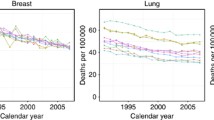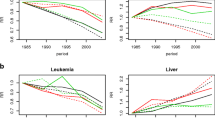A risk-adjusted method is proposed for estimating cancer incidence rates from data collected by the Surveillance, Epidemiology, and End Results (SEER) program of the US National Cancer Institute. Unlike the conventional incidence-rate estimates reported by SEER, this method considers only the first primary cancer, and adjusts for population-based cancer prevalence, as well as for surgical procedures which remove an individual from risk of developing a given cancer. Thus, risk-adjusted incidence-rates more accurately reflect the average cancer risk for individuals in the cancer-free, at-risk population. The results of the analysis indicate that, in general, incidence-rate estimates are fairly similar between the conventional and risk-adjusted methods. However, this is not the case for certain cancer sites which may have: (i) a high number of subsequent primary cancers (e.g., melanomas—skin); (ii) a high cancer prevalence proportion (e.g., prostate cancer); (iii) a high number of subsequent primary cancers and prevalence proportion (e.g., female breast); or (iv) a high prevalence of removal of the organ in question (e.g., cervical and uterine cancers). For example, by applying the risk-adjusted incidence method for in situ and invasive cervical cancer, we found that in the period 1990–92 the age-adjusted incidence-rate estimate increased from 57.8 to 66.3 (15 percent) per 100,000 person-years; the greatest increase in the incidence-rate estimate occurred for women aged 65 to 69 years, from 40.1 to 63.2 (58 percent) per 100,000 person-years; and the lifetime risk of developing cervical cancer increased from 4.6 (1 in 22) to 5.5 (1 in 18) percent.
Similar content being viewed by others
References
Selvin S. Statistical Analysis of Epidemiologic Data. New York, NY (USA): Oxford University Press, 1991.
Ries LAG, Miller BA, Hankey BF, Kosary CL, Harras A, Edwards BK, eds. Cancer Statistics Review 1973–1991. Roskville, MD (USA): National Cancer Institute, 1994; NIH Pub. No. 94–2789.
Verhagen AF, Travilla G, van de Wal HJ, Cox AL, Lacquet LK. Multiple primary lung cancers. Thorac Cardiovasc Surg 1994; 42: 40–4.
Antakli T, Schaefer RF, Rutherford JE, Read RC. Second primary lung cancer. Ann Thorac Surg 1995; 59: 863–6.
Licciardello JT, Spitz MR, Hong WK. Multiple primary cancer in patients with cancer of the head and neck: Second cancer of the head and neck, esophagus, and lung. Int J Radiat Oncol Biol Phys 1989; 17: 467–76.
Prior P, Waterhouse JAH. Multiple primary cancers of the breast and ovary. Br J Cancer 1981; 44: 628–36.
Wassberg C, Thorn M, Yuen J, Ringborg U, Hakulinen T. Second primary cancers in patients with cutaneous malignant melanoma: A population-based study in Sweden. Br J Cancer 1996; 73: 255–9.
Day NE. Cumulative rate and cumulative risk. In Muir C, Waterhouse J, Mack T, Whelan S, eds. Cancer Incidence in Five Continents, Volume V. Lyon, France: International Agency for Research on Cancer, 1987; IARC Sci. Pub. No. 88: 862–4.
Breslow NE, Day NE. Statistical Methods in Cancer Research. Volume 1: The Analysis of Case-control Studies. Lyon, France: International Agency for Research on Cancer, 1980; IARC Sci. Pub. No. 32.
Lyon JL, Gardner JW. The rising frequency of hysterectomy: its effect on uterine cancer rates. Am J Epidemiol 1977; 105: 439–43.
Feuer EJ, Wun L, Boring CC. Probability of developing cancer. In: Miller BA, Ries LAG, Hankey BR et al, eds. Cancer Statistics Review: 1973–1989. Rockville, MD: National Cancer Institute, 1992; NIH Pub. No. 92–2789: 1–8.
Feuer EJ, Wun L, Boring CC, Flanders WD, Timmel MJ, Tong T. The lifetime risk of developing breast cancer. JNCI 1993; 85: 892–7.
Adami HO, Gunnarsson T, Sparen P, Eklund G. The prevalence of cancer in Sweden 1984. Acta Oncologia 1989; 28: 463–70.
Feldman AR, Kessler L, Myers MH, Naughton MD. The prevalence of cancer: estimates based on the Connecticut Tumor Registry. New Eng J Med 1986; 315: 1394–7.
Capocaccia R, Verdecchia A, Micheli A, Sant M, Gatta G, Berrino F: Breast cancer incidence and prevalence estimated from survival and mortality. Cancer Causes Control 1990; 1: 23–9.
US Bureau of the Census, Census of population 1970. In: Muir C, Waterhouse J, Mack T, Whelan S, eds. Cancer Incidence in Five Continents, Volume V. Lyon, France: International Agency for Research on Cancer, 1987; IARC Sci. Pub. No. 88: 792.
Connelly RR, Campbell PC, Eisenberg H. Central registry of cancer cases in Connecticut. Public Health Rep 1968; 83: 386–90.
Gershman ST, Flannery JT, Barrett H, Nadel RK, Meigs JW. Development of the Connecticut Tumor Registry. Conn Med 1976; 40: 697–701.
MacMahon B, Worcester J. Age at Menopause. Washington, DC: US Public Health Service, 1966; USPHS Pub. No. 1000, Series 11, No. 19.
Graves EJ. National hospital discharge survey: annual summary, 1990. Hyattsville, MD (USA): National Center for Health Statistics, 1992; DHHS Pub. No. (PHS) 92–1773, (Vital and Health Statistics, Series 13, No. 112).
International Classification of Diseases, 9th Revision, Clinical Modification, 3rd Ed. Washington, DC: Public Health Service, 1989; DHHS Pub. No. (PHS) 89-1260.
Pokras R, Hufnagel VG, NCHS. Hysterectomies in the United States, 1965–84. Hyattsville, MD (USA): US Department of Health and Human Services, Public Health Service, CDC, 1987; DHHS Pub. No. (PHS)87–1753, (Vital and Health Statistics; Series 13, No. 92)
Goldberg ID, Levin ML, Gerhardt PR, Handy VH, Cashman RE. The probability of developing cancer. JNCI 1956; 17: 155–73.
Zdeb MS. The probability of developing cancer. Am J Epidemiol 1977; 106: 6–16.
Siedman H, Silverberg E, Bodden A. Probabilities of eventually developing and dying of cancer (risk among persons previously undiagnosed with cancer). CA-Cancer J Clin 1978; 28: 33–46.
Pokras R. Hysterectomy, past, present, and future. Stat Bull Metrop Insur Co 1989; 70: 12–21.
Wilcox LS, Koonin LM, Pokras R, Strauss LT, Xia Z, Peterson HB. Hysterectomy in the United States, 1988–90. Obstet Gynecol 1994; 83: 549–55.
Frey CM, McMillen MM, Cowan CD, Horm JW, Kessler LG. Representativeness of the Surveillance, Epidemiology, and End Results program data: recent trends in cancer mortality rates. JNCI 1992; 84: 872–7.
Morris CR, Perkins CI, Wright WE, Snipes KP, Young JL. Impact of inclusion of subsequent primary cancers on estimates of lifetime risk of developing cancer. JNCI 1996; 88: 456–8.
Benichou J, Gail MH, Mulvihill JJ. Graphs to estimate an individualized risk of breast cancer. J Clin Oncol 1996; 14: 103–10.
Wingo PA, Tong T, Bolden S. Cancer statistics, 1995. CA-Cancer J Clin 1995; 45: 8–30.
Giles K, Flynn PJ, Dalton R, Zera R. National Surgical Adjuvant Breast and Bowel Project's Breast Cancer Prevention Trial. Minn Med 1993; 76: 25–7.
Additional information
Drs Merrill and Feuer are with the Cancer Control Research Program of the National Cancer Institute, Applied Research Branch, Bethesda, MD, USA. Address correspondence to Dr Merrill, US National Cancer Institute, Division of Cancer Prevention and Control, Applied Research Branch, 9000 Rockville Pike, EPN 313, Bethesda, MD 20892-7368, USA.
Rights and permissions
About this article
Cite this article
Merrill, R.M., Feuer, E.J. Risk-adjusted cancer-incidence rates (United States). Cancer Causes Control 7, 544–552 (1996). https://doi.org/10.1007/BF00051888
Received:
Accepted:
Issue Date:
DOI: https://doi.org/10.1007/BF00051888




